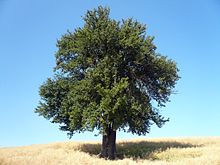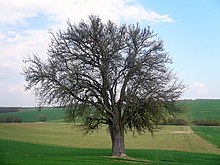Pear tree on the Lerchenberg
The pear tree on the Lerchenberg is a natural monument about one kilometer northwest of the community Schwemmelsbach , a district of Wasserlosen and 15 kilometers west of Schweinfurt in Lower Franconia . The cultivated pear ( Pyrus communis ) is located in the southwestern district of Greßthal , about 500 meters west of the federal highway 7 at 295 meters above sea level on an open area of about ten meters in diameter in a large, slightly south-sloping agricultural field.
description
The trunk appears solid and even, with individual bulging overgrowths. At a height of around three meters, it divides into three strong, vertically rising branches. The course of the trunk-like branches can be followed almost to the ground, as if three trunks have grown together. This is also indicated by growths that run vertically at the seams. Nevertheless, it should be a single-stem grown tree. The crown has a completely harmonious structure, each around 17 meters in diameter and height and has only a small amount of dead wood. The age of the pear tree is given in the literature to be around 150 to 180 years. The Lower Nature Conservation Authority named an age of around 200 years in 1988.
Since January 16, 1989, the tree has been listed as a natural monument by the Lower Nature Conservation Authority of the district of Schweinfurt with the designation 678-N / 79 and the designation Birnbaum am Lerchenberg . In 2008, the trunk had a circumference of 4.56 at the point of its smallest diameter and a height of 4.62 meters. In 1988 the trunk had a height of 15 meters and a crown diameter of 13 meters and a diameter of 1.38 meters at chest height , which corresponds to a trunk circumference of about 4.35 meters. The height of the trunk head, the height where the lowest branches extend, was given as 2.30 meters.
With these dimensions, the pear tree is one of the strongest of its kind in Germany. In addition, it is one of the few pear trees with a trunk circumference of more than four meters and a trunk that is solid and evenly grown. The German Tree Archive describes pear trees from a trunk circumference of four meters at a height of one meter as the most important selection criterion in order to count them among the trees of national importance (NBB). In the literature, in addition to this pear, a total of six other pear trees with a trunk circumference of more than 4.5 meters are listed for Germany. One with 6.90 meters at Grambow (two-stem, trunk relict), one with 5.5 meters near Teisendorf , one with 5.40 meters near Kleinvillars (two-core, refined ), one in Müritz National Park with 5.17 meters (trunk capping) , one at Ützdorf with 5.03 meters (split in two parts) and one at Mittenwald with 5.00 meters in circumference.
See also
literature
- Bernd Ullrich, Stefan Kühn, Uwe Kühn: Our 500 oldest trees: Exclusively from the German Tree Archives . BLV Buchverlag GmbH & Co. KG, Munich 2009, ISBN 978-3-8354-0376-5 , p. 292 .
Web link
Individual evidence
- ↑ a b Bernd Ullrich, Stefan Kühn, Uwe Kühn: Our 500 oldest trees: Exclusively from the German Tree Archives . BLV Buchverlag GmbH & Co. KG, Munich 2009, ISBN 978-3-8354-0376-5 , p. 267 .
- ↑ a b c Information from the Lower Nature Conservation Authority of the district of Schweinfurt.
- ↑ Stefan Kühn, Bernd Ullrich, Uwe Kühn: Germany's old trees . BLV Verlagsgesellschaft, Munich 2007, ISBN 978-3-8354-0183-9 , p. 8 .
- ↑ Bernd Ullrich, Stefan Kühn, Uwe Kühn: Our 500 oldest trees: Exclusively from the German Tree Archives . BLV Buchverlag GmbH & Co. KG, Munich 2009, ISBN 978-3-8354-0376-5 .
Coordinates: 50 ° 4 ′ 8.5 " N , 10 ° 1 ′ 26.6" E



